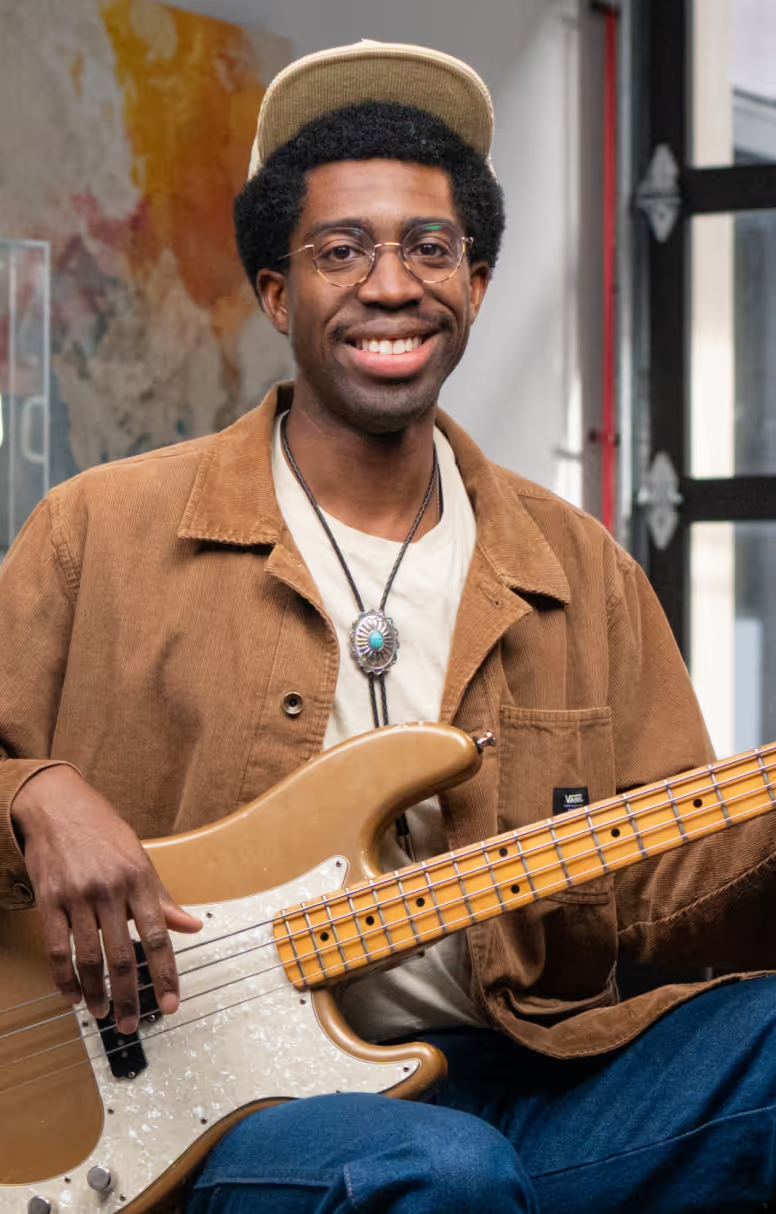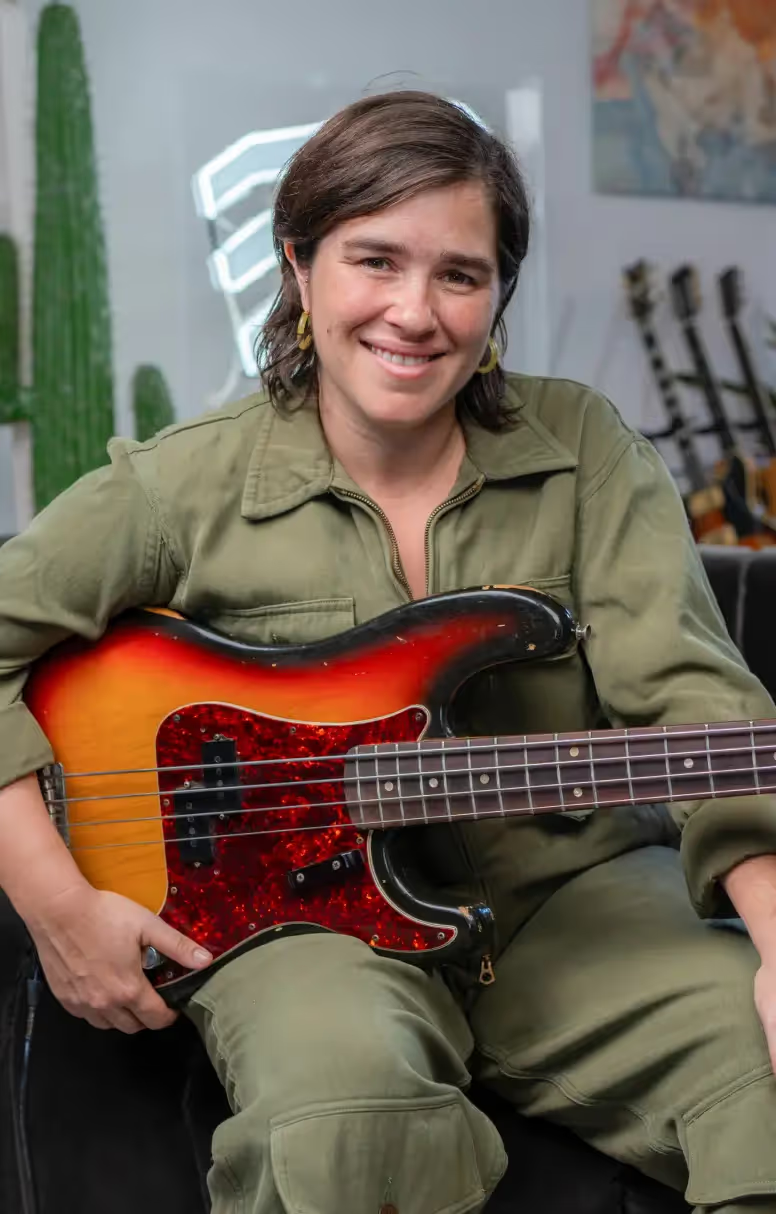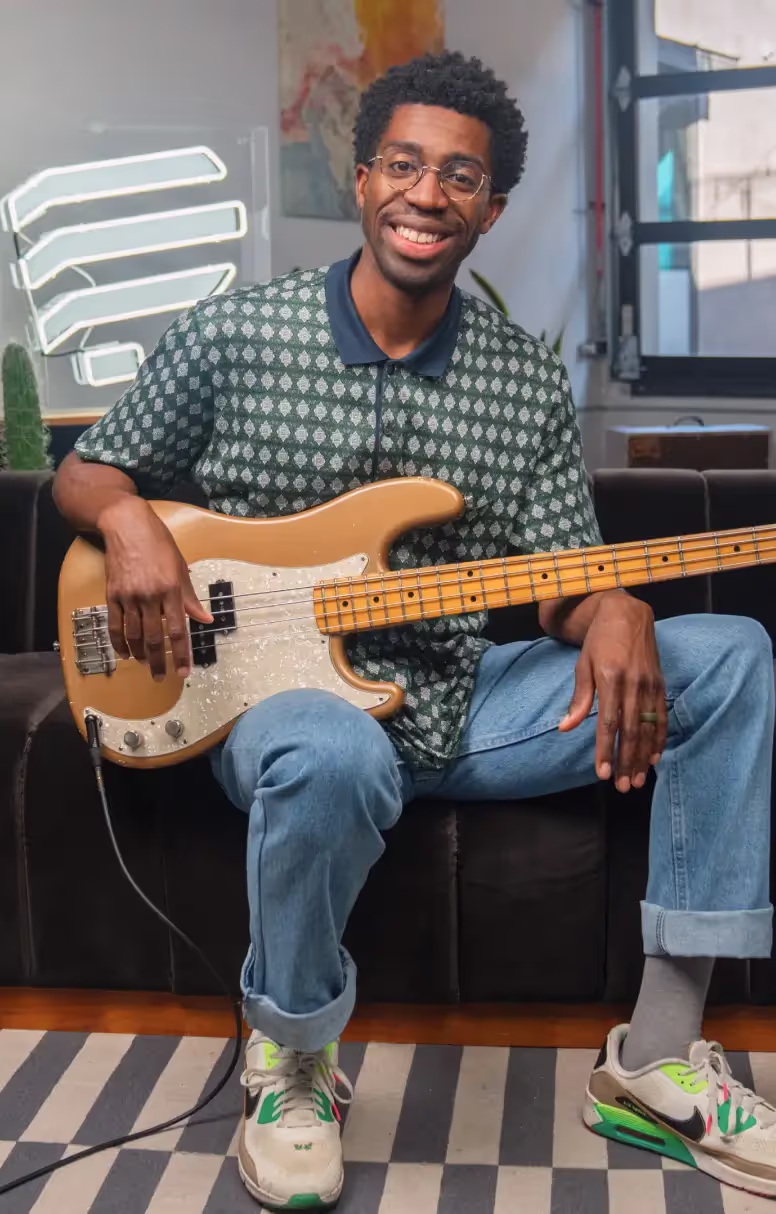Learn Walking Bass in 7 Days
Craft connected basslines for jazz and beyond.
Late beginners
If you’re comfortable with scales and arpeggios but want to capture the driving feel of walking bass, this class is for you.
7 days
Daniel McLaughlin will guide you through 7 days of instruction with daily practice plans and assessments.
Build basslines that flow
By the end of this class, you’ll be able to turn simple patterns into fluid grooves for jazz, pop, and beyond.
Take the next step
Once you've mastered this class, keep learning with more challenges and guided Learning Pathways.
What you'll learn
Each day, Daniel will introduce a new walking bass skill and show you how to weave it into grooves that work across genres. From traditional jazz lines to modern bass parts, this class will help you build fretboard confidence and play with purpose.
- Inject momentum into your basslines
- Navigate chord changes like a pro
- Improve your fretboard fluency
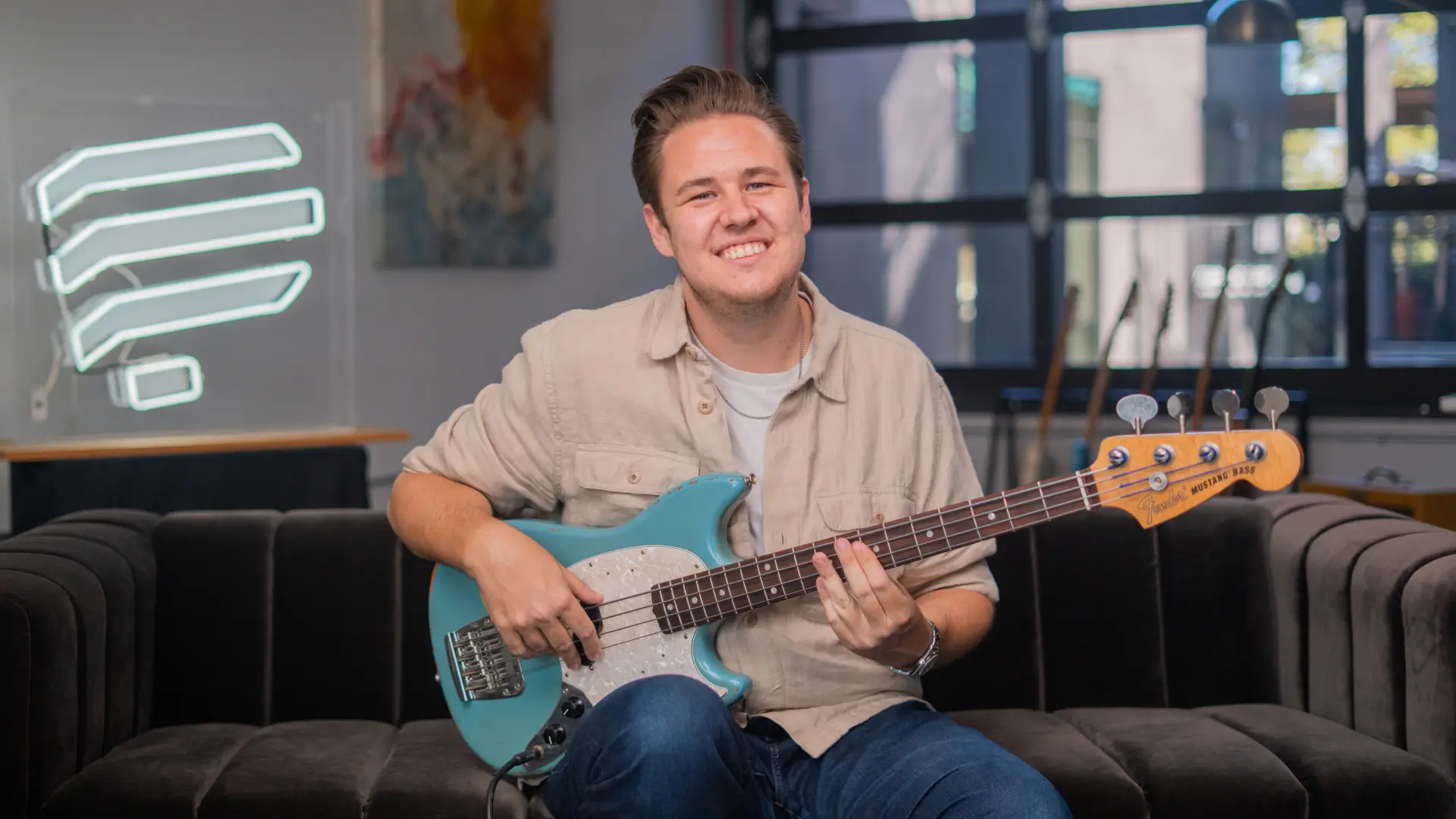
Curriculum
Stay focused with this step-by-step learning program designed by our expert team of music educators.
Your guided challenge
Across 7 days, Daniel will take you on a tour of the core elements behind walking bass and teach you how to apply them in jazz, blues, pop, and beyond. You'll leave this class with a better understanding of your fretboard and the ability to compose your own walking basslines.

Walking blues cliché
We’ll kick things off by learning one of the most iconic walking basslines in music.
In Day 1, Daniel will break down the classic walking-blues cliché and show you how to add motion to your basslines by landing on each quarter note.
You’ll start honing these skills over a 12-bar blues inspired by Rock Around the Clock.
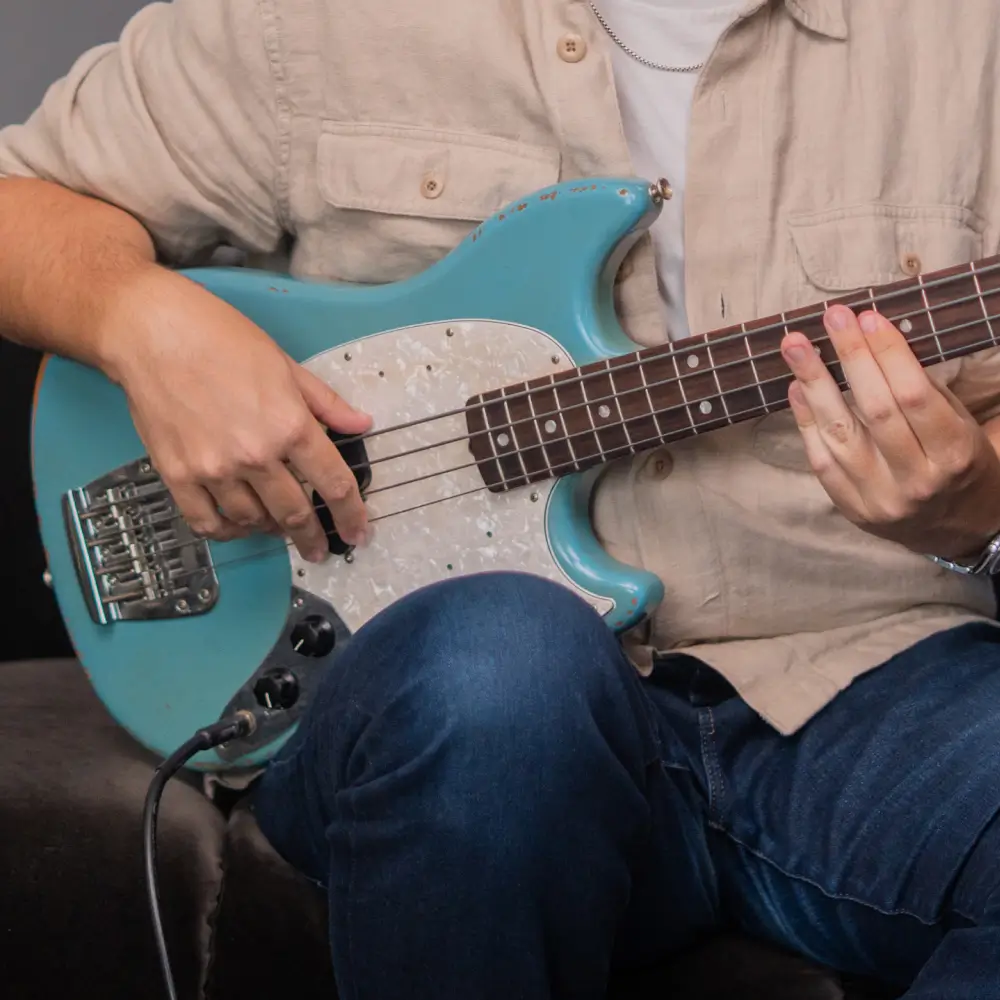
Two feel vs. four feel
Today’s all about groove and feeling. Daniel will teach you the difference between two vs. four feel and show you how to use each one to shape the momentum of a song.
You’ll apply both feels over a jazzy chord progression and start making intentional choices about note length and rhythmic placement.
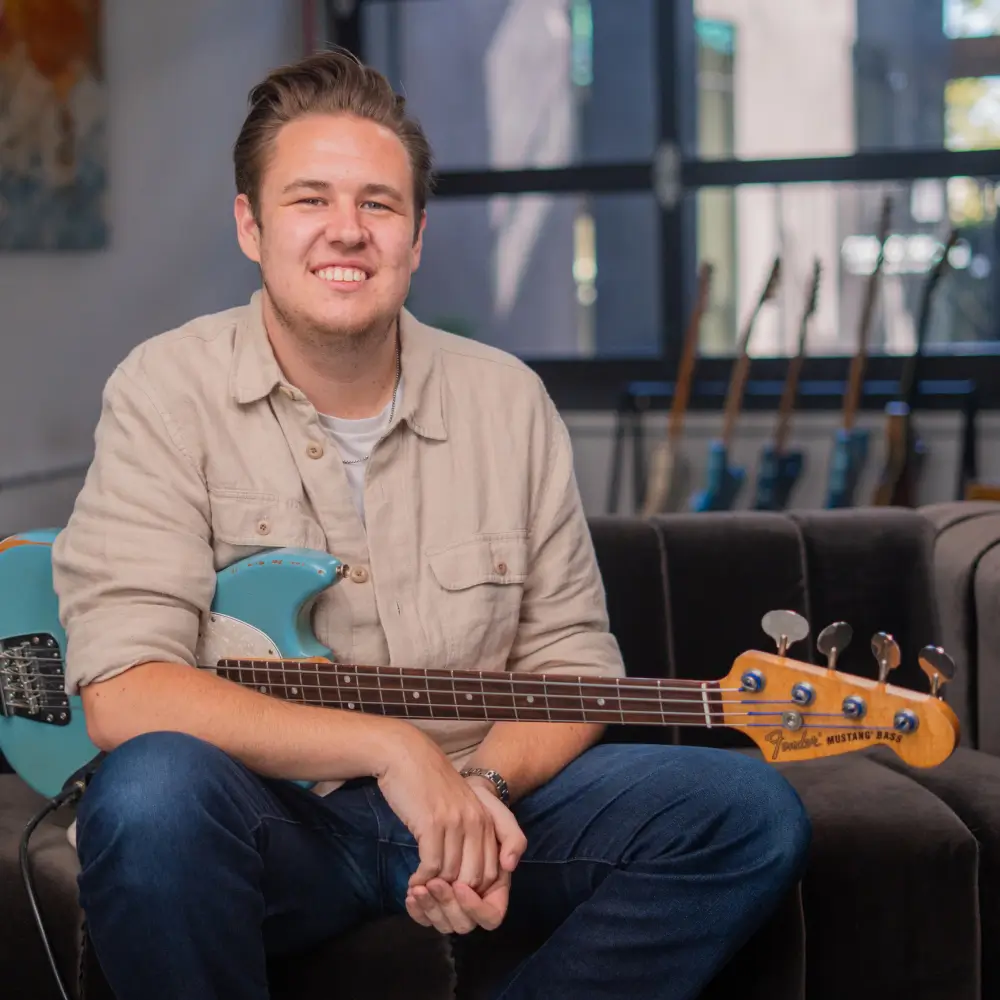
Target notes and chromatic walking
Next, we’ll zoom in on landing strong notes in the right place (the most important aspect of walking bass).
Once you've dialed in your sense of target notes, you'll learn how to approach them chromatically.
You’ll experiment with chromatic walkups and learn how to enclose chord tones for added tension and momentum
Day 5. Stepwise walking
Today, you’ll bring in more melodic motion using scale tones. Daniel will show you how to blend stepwise movement with chromatic ideas to connect chords in creative ways. You’ll also get a taste of jazz harmony with a progression inspired by Autumn Leaves.
Day 6. Intervallic walking
We’ll take a closer look at how intervals shape your basslines. Daniel will break down common intervallic moves to help you outline chords with clarity and intention. You’ll apply these shapes over a bluesy groove.
Day 7. Outliers
On the final day, you’ll add flavor and expression to your walking lines. Daniel will introduce ghost notes, triplets, and octave pedals as a way to bring energy and personality to your playing.
Performances
After your last lesson, you'll have a choice of three performance pieces where you can groove with a live-recorded band to apply what you learned in a purely musical context.
Day 1. Walking blues cliché
In this intro lesson, you’ll start by learning the fundamentals of walking bass and applying them to a 12-bar blues progression.
Who said clichés had to be a bad thing? To kick off the class, you’ll learn the iconic walking bass move.
This lesson is all about what makes a walking bassline different from a normal bassline, as well as how to place your notes to create forward motion.
You’ll then put these skills to the test over a blues track inspired by the iconic ‘50s tune Rock Around the Clock, by Bill Haley & His Comets.
Day 2. Two feel vs. four feel
Learn the two foundational feels for walking bass.
Day 2. Two feel vs. four feel
With your walking-bass basics down, we’ll look at two different ways to feel time that you can use to accentuate the rhythm and add variety to your playing.
You’ll start with a two feel, which consists of notes on the strong beats (1 and 3). Then, you'll move on to a quarter-note pulse, which forms the foundation of walking bass.
To get this idea under your fingers, you'll learn that incorporates both feels as a way to build momentum throughout and avoid "over-walking".
Days 3-4. Target notes and chromatic walking
Learn how to keep your eye on the prize and jazz up your playing.
Day 3. Target notes
They say it’s about the journey, not the destination, but in walking bass, your destination shapes the entire path.
In this lesson, Daniel will show you how to approach root notes using half- and whole-step approaches to emphasize chord changes. Using a Van Morrison-inspired track, you’ll focus on the strongest beat of all: the 1.
Day 4. Chromatic walking
As long as you know your target notes, there are few limits to the number of notes you can use to approach them. Using chromatic walking lets you experiment by adding different levels of momentum and tension leading up to your root note.
Daniel keeps it tame in this lesson with 3- and 4-note approaches over a track inspired by Hey Joe, performed by Jimi Hendrix. You’ll also learn how to enclose your root note to incorporate melodic movement in your bassline.
Days 5-7.
To wrap up the class, we'll explore different ways you can approach your target notes and explore three outlier techniques to take your playing further.
Day 5. Step-wise walking
Chromatic walking will serve you in many situations, but what if you want to add a little melody to your lines? Well, in this lesson, you’ll learn how to use the scale of the chord you’re playing over to follow the chord changes more precisely and place your notes to emphasize the strong beats.
You’ll learn how to walk up using perfect 4th intervals and walk down using perfect 5th intervals. By combining step-wise walking with chromatic walking, we can outline the chord without losing the forward momentum leading back to the root.
Day 6. Intervallic walking
Throughout this class, we’ve been using intervals, but today we put a name to it and explore the theory. Thinking about walking basslines through the lens of intervals helps us better understand how the notes we’re playing interact with scales and chords.
We’ll look at several common types of intervallic walking basslines, including dominant 7th arpeggios, 6ths, and octave leaps. Using these in your playing will perk up your listener’s ear and complement the chords.
Day 7. Outliers
Now that you’ve got the fundamentals of walking bass down, you probably want to learn how to add your personal touch to the basslines we’ve been playing. In this final lesson of the class, you’ll explore three more advanced techniques that you can use to add flavor to your lines.
Ghost notes will let you think like a drummer and subdivide the beat. Triplets help you emphasize the swing feel of a song. Finally, you’ll learn how to bring attention to the most important note of all with the octave pedal.
Performances
Now that your walking-bass skills are locked in, you’ll get three chances to apply them to genre-spanning tracks. Time to show off those new walking-bass skills.


FULL REFUND, NO QUESTIONS ASKED
If you don’t get better, we’ll give you your money back
We’re so confident that Pickup Music can help you make progress that we’re underwriting your membership with a 60-day satisfaction guarantee.

Your Instructor
Learn how to walk the walk. With Daniel’s clear, musical approach to teaching, you'll master walking basslines that groove across genres.
Explore LessonsLimitless learning.
All-inclusive access to every course.
Frequently Asked Questions
Got a different question? Message us in the chat pop-up.
⚡️ Getting started
Is Pickup Music right for me?
Are you a bass player who feels like you haven’t made progress in a few months… years… or even decades?
You’re probably stuck in what’s called the ‘intermediate plateau’. This is very common and can be very frustrating.
What’s the cause? Well, it’s pretty easy to learn the basics on bass.
But what then? Triads? Modes? Arpeggios? The phrygian scale?!
Without a clear plan and learning system you fall back to playing the same old lines over and over again. Or you bounce around free lessons online but nothing seems to stick. It’s a recipe for a lot of practice without much progress.
That’s where Pickup Music can help. We specialize in taking players stuck in a bass rut and turning them into advanced bassists.
We do this through Learning Pathways that take you on a step-by-step journey towards fretboard mastery. We give you a highly structured system that shows you exactly what to work on each week to make serious progress.
These Learning Pathways take the guesswork out of your practice routine. You are guided through a proven grade-by-grade system with daily lessons, play-along practice exercises and interactive workouts.
But it’s not all about theory. We apply everything you learn to real music. That’s why every grade of our Learning Pathways build up to performing a song with a live backing band. This simulates what it’s like to play a real gig, with real musicians. It’s the absolute best way to learn.
You also get 1:1 video feedback on your playing from our expert instructors and can attend weekly live lessons. This personal feedback makes Pickup Music the closest thing to taking in-person lessons, but at a fraction of the cost.
So does this method actually work? Will you see results in your playing?
The most common thing we hear from new members is that they’ve made more progress with Pickup Music in a few months than in years of teaching themselves. As one member recently told us, “I'm finally seeing progress for the first time in many years”.
Want to hear about other members’ experiences with us? Read our independent Trustpilot reviews.
Is Pickup Music worth the money?
Private bass lessons will cost you at least $50 per lesson or $2,600 a year.
Going to a music academy will cost you about $40,000 a year.
A Pickup Music membership will cost you just $180 for the whole year.
That works out to 50 cents a day!
But it’s not just about the money. It’s about not wasting your precious time. It’s about making actual progress on this beautiful instrument.
By following our proven Learning Pathway system, you can stop wasting your time and effort trying to guess what you should practice next. Our guided programs eliminate the guesswork so you know exactly what you need to focus on each day and week to make lasting progress with bass.
What makes Pickup Music better than other bass lesson sites?
Most online bass lesson sites are very good at teaching one-off styles and techniques. Or they get super famous bassists to record one-hour video lessons talking at length about their particular style and career.
The problem is that these approaches don't stick. They don’t help you to actually get better as a bassist. You can waste a lot of time bouncing around these types of unconnected, one-off lessons. It’s a recipe for a lot of practice without much progress.
Pickup Music takes a different approach. We give you a highly structured system that shows you exactly what to work on each week to make serious progress. We take you beyond the basics through a step-by-step journey towards fretboard mastery.
By following a Pickup Music Learning Pathway, you are getting the most guided way to learn bass. Over 6 grades, you are taken through daily lessons and practice exercises that carefully explain what’s going on behind the music.
Each grade then builds up to song performances that apply everything you’ve learned with a live backing band. These challenges - where we simulate what it’s like to play a real gig, with real musicians - is the absolute best way to learn.
The Learning Pathway method takes the guesswork out of your practice routine. Most bassists start to see a rapid acceleration in their progress in a matter of weeks.
You can also get 1:1 video feedback on your playing and weekly live lessons. This personal feedback makes Pickup Music the closest thing to taking in-person lessons, but at a fraction of the cost.
Want to hear about other members’ experiences with us? Read our independent Trustpilot reviews.
What exactly do I get from a Pickup Music membership?
When you become a Pickup Music member you get unlimited access to our huge library of lessons across both guitar and bass.
You get to enjoy amazing features that create a premium learning experience:
- day-by-day lessons
- 1:1 video feedback on your playing
- weekly live lessons
- progress tracking
- interactive TAB
- multiple HD camera angles
- play-along practice exercises
- downloadable course notes and diagrams
- quizzes to test your understanding
- jam tracks with the Pickup Music Live Band
- exclusive members-only forum, contests and giveaways.
How do the Learning Pathways work?
Learning Pathways are kind of our special sauce here at Pickup Music. They take all the guesswork out of what to practice.
You get day-by-day lessons, play along practice exercises with your instructor, interactive jams with the Pickup Music live band and you can submit videos of your playing for feedback from the Pickup Music team.
We designed this system so that you will know exactly what to practice every time you pick up the bass. This means that even if you only have time to practice with us once a week, you will still make great progress by following a Learning Pathways.
How often do I need to practice to see results?
Ideally you would practice about three times a week for 30 minutes at a time. But we know that life gets in the way sometimes! So here’s the good news: deliberate practice matters so much more than how often you practice.
After working with thousands of bassists, we’ve found that the most important thing is to know exactly what you’re going to practice before you pick up the bass. Even if you can only use Pickup Music a few times a month, you will still make really good progress if you stick to the step-by-step structure of our Learning Pathways.
Can I take the lessons at my own pace?
Everything on Pickup Music is designed to be taken at your own pace. There are no deadlines, so you can work at your own speed. You can stay on a topic until you really understand it before you move on.
While we divide our Learning Pathways into ‘days’ - this is a suggestion only. Some learners might take a few days in one sitting, while others will spend a few sessions on a single day. You can go at the pace that feels most comfortable to you.
How does the 1:1 video feedback work?
We want our members to get the closest thing possible to in-person lessons but at a fraction of the cost. That's why you can now get individual video feedback on your bass playing from our team of expert instructors.
Here's how it works:
- Choose a performance piece to learn at the end of each grade of a Learning Pathway.
- Upload a video of yourself playing the performance piece.
- An expert instructor from our team will review your playing and send you back a detailed video on what you're doing well and what you need to work on.
- Repeat for each grade of the Learning Pathway.
I'm brand new to bass. Is Pickup Music the right choice for me?
Absolutely! We make learning the bass fun and simple – the way it should be.
Too many people get frustrated with bass because they develop bad habits and poor technique. Avoid these costly and time-consuming mistakes by taking Pickup Music's structured and step-by-step approach to learning bass.
You'll start with Pickup Music's introductory program Beginner Learning Pathway. Over a few weeks, we break down everything from simple chords and melodies to rhythm and lead playing. By the end of the program, you'll be able to play any simple pop or rock song (and even write your own).
Most importantly, we make sure you don't get stuck in the beginner's plateau - a common pitfall for bassists who are just starting out. You'll keep making progress through Pickup Music's guided Learning Pathways. These programs are designed to quickly take you from a beginner player to an intermediate one who feels comfortable across the whole fretboard.
Is Pickup Music good for intermediate and advanced bassists?
Pickup Music is the best platform available for intermediate and advanced bassists. Our courses take you beyond the basics to advanced concepts like triads, arpeggios, modes and improvisation.
The biggest trap for intermediate players is bouncing around from lesson to lesson without a plan or structure to get to that next level. We are known for taking intermediate and advanced players who have hit a ceiling and busting through until they reach the next level.
Am I too old for bass lessons?
Many of Pickup Music’s members are in their 60s and 70s and have seen amazing success with our programs. Our platform is designed to be user-friendly for all ages and skill levels. And our supportive community is made up of bass learners of all ages, cheering each other on.
Do I get access to the guitar lessons as well?
Yes. You get unlimited access to all of our guitar and bass lessons under the one membership.
💳 Pricing and plans
How does the 14-day free trial work?
When you first sign up to a Pickup Music membership, you enter your credit card but it will not be charged for 14 days. That means that if you decide to cancel within 14 days of signing up, you won't pay anything.
And we send you a reminder before your trial is about to end so you don’t forget about it.
If you decide to cancel after that, you won't be charged at your next billing cycle. That means: if you’re a monthly member, you won’t be charged for the next month. If you’re an annual member, you won’t be charged for the next year.
How does the 60-day money back guarantee work?
In addition to the 14-day free trial, we offer a 60-day money back guarantee. If you’re not satisfied with your progress in the first 60 days of your membership, we will give you your money back - no questions asked.
Please note: The 60-day money-back guarantee does not apply to app purchases made via Apple.
Is it easy to cancel?
Canceling is easy. It’s just one click of a button on your account page.
You won't be charged anything if you cancel during your 14-day free trial. We also send you a reminder before your trial ends so you don’t accidentally forget about it.
If you cancel after your 14-day trial, you won't be billed again at your next billing cycle. Your membership will remain active until it expires on the day it was originally set to renew.
What’s the difference between the annual and monthly plan?
The only difference is the price. The monthly membership is $29.99 charged monthly and the annual membership is $179.99 charged once a year.
That means that if you select the annual plan you will pay 50% less and save $180 over a year compared to the monthly plan.
We'll also send you reminders before we bill you each year so that you don't accidentally forget about it.
We give such a big discount for annual members because it aligns with our long-term vision to inspire and support lifelong bass learning.
Can I buy lessons individually?
We don’t sell lessons individually. But the good news is you get access to every single lesson on Pickup Music through the one membership. If you’re only interested in one lesson, you could purchase a monthly membership and cancel when you’ve finished it – we have a hunch you’ll want to stick around though :)
How do I restart my membership?
It’s easy to rejoin Pickup Music and we’d be thrilled to have you back! We even saved all of your lessons for you while you were gone on your My Classes page.
To restart your membership, log in with the email address you used to sign up the first time around and then select the plan of your choice.






